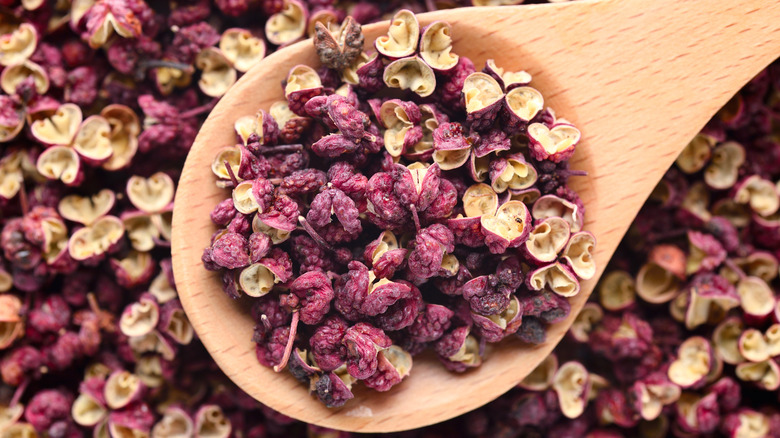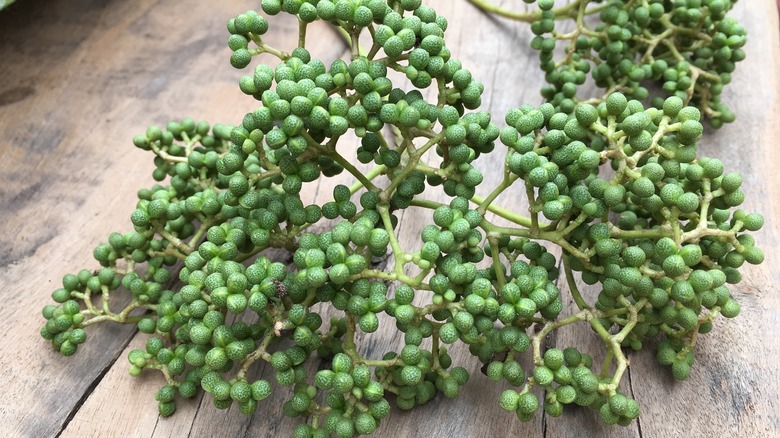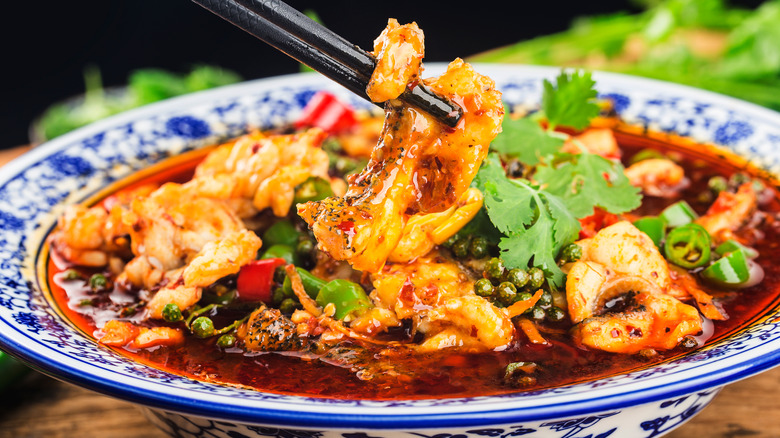Sichuan Peppercorns Aren't Really Peppercorns. So What Are They?
Pepper isn't always pepper. What do we mean? Well, while green peppercorns are the unripe version of common black pepper, Piper nigrum, pink peppercorns come from the Baies rose plant. And while Sichuan, or Szechuan, peppercorns are pretty in pink, they have no relation to pink peppercorns. Sichuan pepper packs a peppery punch and is quintessential in Sichuan Chinese cooking. However, they are not actually peppercorns either, despite the piquant taste. Instead, they come from a small, shrubby, spiny tree called the prickly ash or Zanthoxylum. There are many species of the tree, and it falls under the tropical citrus or Rutaceae family. Both the leaves and the berries have a distinctly citrusy taste and smell.
Small green flowers produce berries that ripen from green to vibrant pinkish red. The Sichuan peppercorn can be eaten raw or dried, unripe or ripe. There is a small black seed that has an unpleasantly gritty texture. In dried treatments of the ripe peppercorns, the berry is husked and the seed discarded. In the unripe berries, the seed is still small and soft enough to eat.
The terminology in English can be confusing. Green Sichuan peppercorns, qīng huājiāo, which come from a different type of prickly ash tree than their ripened red counterparts, have no relation to green peppercorns. Let's take a closer look at Sichuan peppercorns, huā jiāo.
Málà – what it is, and why it's so special
Málà is the anglicized pronunciation of two Chinese characters. "Má" translates to numbing, and "là" translates to spicy or hot. The name refers to the flavor and sensation experienced when Sichuan peppercorn, the numbing component, is combined with dried and fresh chilies, the hot components.
While Sichuan cuisine has a reputation for being spicy food, chilies were not used in China until after they were brought in from the Americas by Portugal. The Sichuan peppercorn was a main source of heat (when coupled with things like ginger), but the flavor is unique. It is slightly bitter, floral, and citrusy, with a taste that changes and builds as you eat it. Distinctly, the Sichuan numbing quality starts as tingling and intensifies to a brief loss of sensation in the mouth and tongue.
Despite the relative newness of chilies in Sichuan cuisines, the combination with the existing use of the Sichuan peppercorn was a perfect match. Dishes with málà have an irreplicable complexity. The sharp heat of the chilies and the numbing feeling of the Sichuan peppercorns creates a full and layered experience sure to be appreciated by heat seekers. J. Kenji Lopez-Alt describes the málà love affair beautifully saying, "It's dangerously captivating stuff. Just as your mouth seems about to spontaneously combust from the chili heat, the Sichuan peppers kick in, numbing it back to soothing calmness, so you can take another bite and start the whole process over again."
What are the traditional uses of Sichuan peppercorns
The dried, de-seeded, husks of the ripened Sichuan peppercorns are most commonly used. Like other whole spices, toasting them releases the natural oils, creating complexity.
Sichuan peppercorns are widely used in stir-fries, braises, soups, noodle dishes, and rice plates. Mapo tofu is a classic málà dish. It combines medium or firm silken tofu and sauteed ground beef in a silky sauce of garlic, ginger, fermented bean paste, dark soy sauce, Xiaoxing wine, chili oil, and Sichuan peppercorns. Stir-fried Sichuan-style dan dan noodles have lots of regional variations, but often include ingredients like ground pork, sesame paste, Chinese five spice, pickled vegetables called sui mi ya ci, and a generous amount of Sichuan peppercorn chili oil. Sichuan boiled fish is a dish where sliced filets are poached in a scallion, ginger, and garlic broth. The hot broth is poured over vegetables like bean sprouts, and the whole dish is covered in fragrant and spicy chili oil made from both red and green Sichuan peppercorns. Served with rice, this recipe is another unforgettable málà specialty.
The taste of Sichuan peppercorns really can't be replicated, and if you're unfamiliar with the flavor profile, it can take some trial and error to find a happy medium in your home cooking. Get acquainted by dining out at a Sichuan Chinese restaurant to get the full málà experience.



